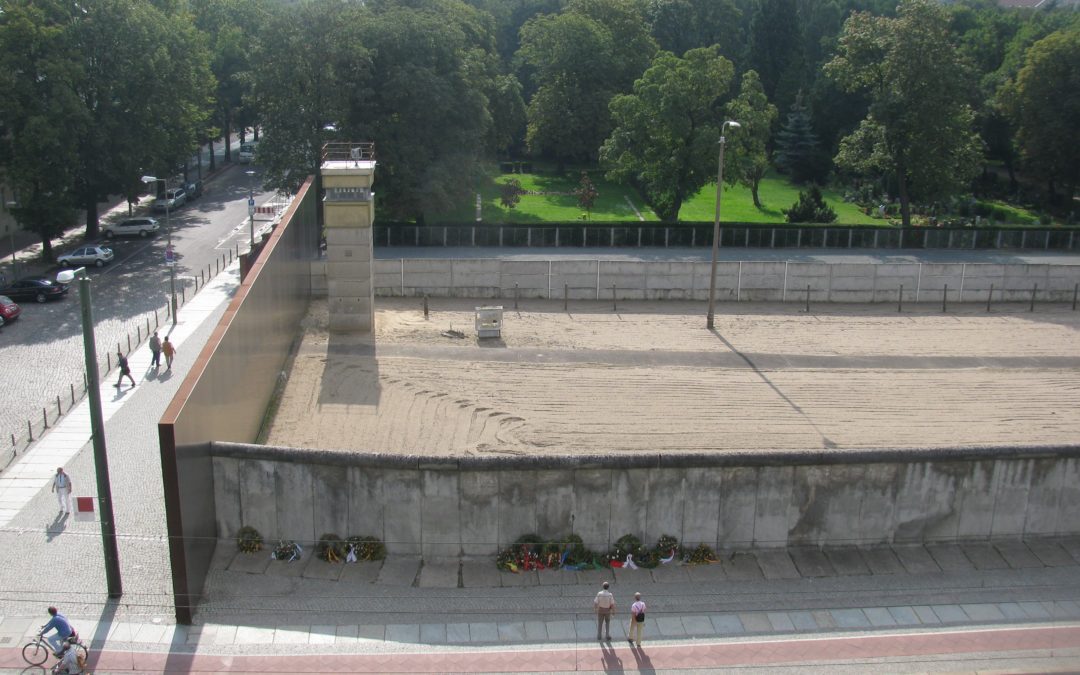An elderly man shoves two packages out of a fourth floor window, and then he crawls out and sits on the ledge, staring down at the ground below. Then slowly, carefully, he turns himself around, lowers himself from the ledge, and lets go, plunging down four stories, his lightweight jacket flung upwards by the rush of air.
He lands squarely in the safety net below.
You can see this dramatic scene in a 3-minute YouTube video showing clips of scenes filmed shortly after the Berlin Wall was constructed in August of 1961. Nowhere were these scenes more dramatic than along the street, Bernauer Strasse, where people literally leaped to freedom. That is why Bernauer Strasse plays such a key role in my historical novel, The Puzzle People: A Berlin Mystery.
East Germany constructed the Wall to prevent its citizens from fleeing their Communist “paradise” to reach the free democracy of West Germany. But on the street known as Bernauer Strasse, the Wall initially ran right up against some of the buildings. If you were inside the buildings, you were in East Berlin, but step through the front door (or jump through a window) and you were in West Berlin.
In the early days after the Wall was constructed, people used the buildings as escape routes to the West, but the East Germans soon acted to brick up the windows and tear down the buildings. They then began to build what became known as the death strip.
Eventually, two walls ran along the border between East and West Berlin: â€an inner and an outer wall. In between the two walls was the death strip, bristling with booby traps, guard dogs, fences, obstacles, and watchtowers where guards had shoot-to-kill orders.
There was also a church in the death strip.
The Church of Reconciliation on Bernauer Strasse became trapped in the death strip–with “reconciliation” being an ironic name for a church found along the border of a divided country.
Caught in the death strip, the church remained empty from 1961 until 1985. That’s when the East German government decided the church had to be destroyed because it had become a symbol of the insanity of the Berlin Wall. So the East Germans detonated the church, and the structure came crashing down in a cloud of smoke and debris. The cross on top of the church went flying into a nearby cemetery.
Images of the destruction of the church flashed around the world, creating an even more powerful picture of the lengths to which Communist East Germany would go to keep its own citizens imprisoned behind a Wall.
Today, the Wall is gone, Germany is united, and Bernauer Strasse is peaceful. But you can still find a remnant of the death strip preserved on this street, and next to it stands a new chapel–the Chapel of Reconciliation.
If you look on the ground outside the chapel, you can see the outline showing where the old Church of Reconciliation once stood, and you can see the cross that was flung off the steeple when the church was blown up in 1985. The chapel is modern, with its sanctuary built into a circular core made of a compressed earth. Mixed into the compressed earth of the chapel are bits and pieces of the old church that was blown up.
In a way, you might say that the chapel contains bits and pieces of the “body” of the old church–a symbol of communion.
The Church of Reconciliation could not be destroyed, and neither could the work of Jesus, who came to bring reconciliation and forgiveness. Every Easter season, we celebrate the fact that the powers of this world could not keep Jesus in the grave. He rose again, just as the Chapel of Reconciliation rose up on the same patch of ground where the East German powers tried to destroy the church.
We all live in a death strip of sorts–a world filled with danger and suffering. But Christ entered the death strip, and He cleared the path and tore down the walls separating us from New Life. He went before us, so we needn’t be afraid of death.
He is the Life and the Resurrection. No wall on earth can keep us from this Life, and no death strip in the universe can separate us from the One who gives us Life.

The interior of the Chapel of Reconciliation. The carving of the Last Supper was taken out of the original church before it was blown up.
By Doug Peterson

